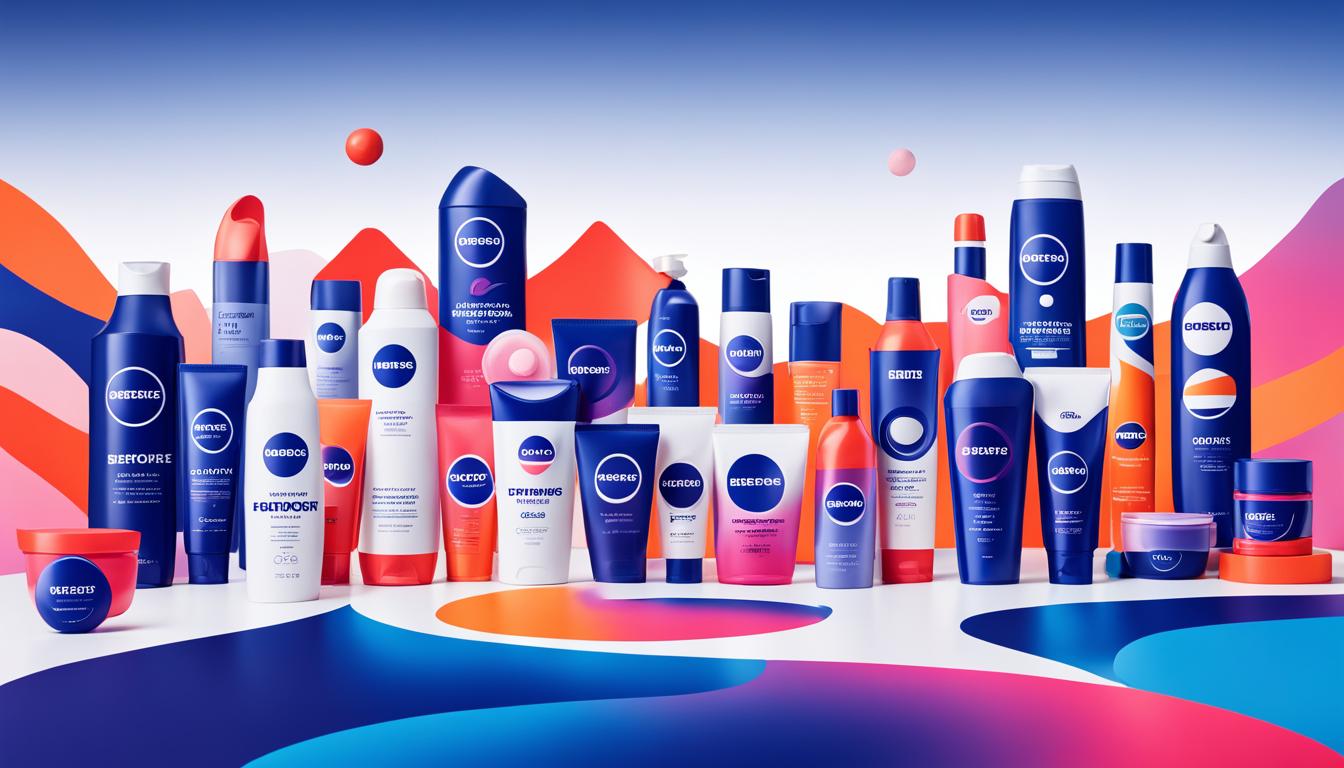Foot Locker, a prominent player in the athletic footwear and athleisure apparel industry, has been implementing a robust marketing strategy to maintain its leadership position. With a focus on retail marketing tactics, digital advertising campaigns, and brand loyalty initiatives, Foot Locker has successfully navigated the competitive landscape of the athletic shoe industry.
Recognizing the influence of sports culture and the significance of branding, Foot Locker has established itself as a go-to destination for both athletes and fashion-conscious individuals. The company’s marketing efforts have been centered around engaging with its target audience through innovative strategies that resonate with their passion for self-expression.
Moreover, Foot Locker has embraced omnichannel retail strategies to provide a seamless shopping experience for its customers. By integrating online and offline channels, the company ensures that consumers can interact with the brand in multiple ways, fostering convenience and accessibility.
Key Takeaways:
- Foot Locker’s marketing strategy focuses on retail marketing tactics, digital advertising campaigns, and brand loyalty initiatives in the athletic shoe industry.
- The company understands the importance of sports apparel branding and engaging with the passion for self-expression among its target audience.
- Foot Locker leverages omnichannel retail strategies to provide a seamless shopping experience for customers.
Exploring Foot Locker’s Roots
Foot Locker, a prominent retail chain in the athletic footwear industry, has a rich history that dates back almost 150 years. The roots of the company can be traced back to Frank Winfield Woolworth, the founder of the iconic retail chain. Woolworth’s visionary ideas and innovative strategies played a significant role in shaping the success of his business.
In the late 19th century, Woolworth introduced the concept of a 5-cent store, where customers could purchase a variety of items at affordable prices. This revolutionary approach attracted a large customer base and quickly propelled Woolworth’s business forward. Additionally, Woolworth implemented a profit-sharing system with store managers, which motivated and incentivized their performance.
During the same era, another prominent figure in the footwear industry was making his mark. George Kinney established a small shoe store called Kinney Shoes, focused on providing affordable footwear to lower-class shoppers. Kinney’s commitment to offering quality products at accessible prices resonated with customers, establishing a loyal following.
Interestingly, Woolworth and Kinney employed similar strategies to drive their respective businesses. Both implemented innovative approaches to motivate their employees and attract customers. This shared entrepreneurial spirit would later intertwine the paths of these two retail giants.
| Year | Event |
|---|---|
| 1879 | Frank Winfield Woolworth opens his first store in New York City |
| 1894 | George Kinney starts Kinney Shoes, focusing on affordable footwear |
| … | … |
When Woolworth Met Kinney
Following World War II, Foot Locker faced several challenges in the retail industry. The company had to navigate changing consumer spending patterns and increased competition, which required them to develop innovative retail management strategies. To overcome these post-WWII challenges, Foot Locker embarked on an ambitious expansion plan to modernize its operations.
Under the leadership of Robert Kirkwood, Foot Locker upgraded existing stores and opened new branches as part of their expansion efforts. This allowed the company to better meet the evolving needs of their customers and stay ahead of the competition. By implementing these retail management strategies, Foot Locker was able to overcome operational issues and increase sales.
During this transformative period, Foot Locker also encountered Kinney Shoes, a footwear retailer that would later become a part of the Foot Locker brand. Recognizing the potential synergy between the two brands, Woolworth made the decision to merge with Kinney Shoes, expanding their market presence and further solidifying their position in the industry.
The merger with Kinney Shoes was a pivotal moment in Foot Locker’s history, allowing the company to leverage the strengths of both brands and gain a competitive edge. This strategic move not only expanded Foot Locker’s reach but also brought together a wealth of expertise and resources to fuel further growth and success in the athletic footwear and athleisure apparel industry.
Foot Locker’s Lace Up Strategy
As part of its forward-thinking approach, Foot Locker has developed a comprehensive marketing strategy for 2024, known as the “Lace Up” strategy. This strategy encompasses several key areas, including the expansion of sneaker culture, the relaunch of the brand, the introduction of new store formats, and the enhancement of the customer experience online.
One of the primary objectives of Foot Locker’s Lace Up strategy is to further cultivate the influence and impact of sneaker culture. Foot Locker recognizes the significance of sneakers as more than just footwear, but as a form of artistic expression and cultural phenomenon. By amplifying this culture, Foot Locker aims to forge deeper connections with its target audience, driving engagement and loyalty.
In addition to elevating sneaker culture, Foot Locker plans to revitalize its brand through captivating initiatives. By reimagining its image and reinforcing its position as a leading retailer in the athletic footwear and athleisure apparel industry, Foot Locker aims to attract new customers and reignite enthusiasm among existing ones.
The Lace Up strategy also entails the introduction of innovative store formats. Foot Locker aims to optimize its physical locations to create immersive shopping experiences that cater to the evolving expectations of customers. By crafting engaging environments that blend technology, design, and product curation, Foot Locker seeks to provide customers with a unique and memorable in-store experience.
Recognizing the importance of the digital landscape, Foot Locker aims to enhance the customer experience online. The company plans to leverage its digital platforms to offer seamless browsing, personalized recommendations, and convenient online shopping options. By leveraging data and insights, Foot Locker strives to provide a tailored and interactive digital experience that resonates with customers.
To ensure the success of the Lace Up strategy, Foot Locker has outlined important tactics, including the closure of underperforming stores and the opening of new format stores. By strategically optimizing its store portfolio, Foot Locker aims to maximize its presence in key markets and better cater to customer demands.
Furthermore, Foot Locker plans to deepen its partnerships with influential brands, such as Nike. Collaborations and joint marketing efforts will reinforce Foot Locker’s position as a trusted destination for premium athletic footwear and apparel.
Overall, Foot Locker’s Lace Up strategy for 2024 exemplifies the company’s commitment to staying ahead in the competitive retail landscape. By embracing sneaker culture, innovating store formats, and prioritizing the customer experience, Foot Locker aims to achieve 5-6% sales growth from 2024 to 2026.
| Foot Locker’s Lace Up Strategy Analysis | Impact |
|---|---|
| Expanding sneaker culture | Increased engagement and brand loyalty |
| Relaunching the brand | Attracting new customers and reinforcing brand image |
| Introducing new store formats | Enhanced in-store experiences and increased foot traffic |
| Improving the customer experience online | Increased online sales and customer satisfaction |
| Closure of underperforming stores | Optimized store portfolio and cost savings |
Foot Locker’s Creative Advertising Strategy
Foot Locker, a leading retail brand in the athletic footwear industry, has implemented a creative advertising strategy to enhance its brand visibility and drive customer engagement. Through a combination of innovative marketing techniques and cutting-edge technology, Foot Locker has successfully elevated its advertising campaigns to new heights, resulting in increased click-through rates (CTR) and a reduction in cost-per-acquisition (CPA).
One of the key components of this strategy is the incorporation of Gen AI into the ad creative and production process. Gen AI is a powerful artificial intelligence tool that utilizes machine learning algorithms to generate captivating and highly personalized product ads. By leveraging Gen AI, Foot Locker has been able to create over 10,000 unique ad variations tailored to different platforms and target audience segments.
The use of Gen AI has yielded remarkable results for Foot Locker. The company has experienced a significant 32% increase in click-through rates, indicating a higher level of engagement from consumers. This increase in CTR not only reflects the effectiveness of Foot Locker’s creative advertising but also translates into a greater likelihood of conversion and a higher return on investment.
In addition to improving CTR, Foot Locker has also achieved a reduction in cost-per-acquisition. By leveraging Gen AI to create more targeted and relevant ads, the company has been able to optimize its advertising spend and attract high-quality leads at a lower cost. This reduction in CPA has not only improved the efficiency of Foot Locker’s marketing efforts but has also allowed the brand to allocate resources to other critical areas of the business.
Furthermore, Foot Locker’s creative advertising strategy has helped the brand establish a stronger presence in the digital space and capture the attention of its target audience. Through visually appealing and engaging ads, Foot Locker has been able to effectively communicate its brand message and stand out among competitors in a crowded marketplace.
With its innovative approach to retail brand marketing, Foot Locker continues to set industry benchmarks and drive growth through creative advertising. By leveraging technologies such as Gen AI, the company has not only achieved significant improvements in CTR but has also successfully reduced CPA, ultimately maximizing the impact of its advertising campaigns. As Foot Locker seeks to further enhance its market position, its creative advertising strategy will undoubtedly play a pivotal role in propelling the brand forward.
Foot Locker’s Brand Loyalty Initiatives
Foot Locker understands the significance of brand loyalty and has implemented a range of initiatives to engage and retain customers. Central to these efforts is the company’s loyalty program, designed to offer rewards and personalized experiences to its members. Through this program, Foot Locker aims to provide tailored recommendations and promotions, enhancing the overall customer experience. By leveraging customer data and analytics, the company can better understand individual preferences and interests, enabling them to deliver targeted offers that resonate with their audience.
Foot Locker Rewards Program
The cornerstone of Foot Locker’s brand loyalty initiatives is their rewards program. This program encourages customers to engage with the brand by offering exclusive benefits and rewards. By enrolling in the program, customers can earn points for their purchases, which can be redeemed for discounts, special promotions, or even unique experiences.
- Earn points for every dollar spent
- Access to exclusive promotions and events
- Early access to limited-edition releases
- Free shipping on online orders
Personalized Experiences
Foot Locker’s commitment to personalized experiences goes beyond their rewards program. By utilizing customer data, the company can provide personalized product recommendations based on individual preferences and browsing history. This targeted approach helps customers discover items that align with their style and interests, enhancing their overall shopping experience.
Additionally, Foot Locker leverages personalized messaging and offers to engage customers and foster a sense of exclusivity. By sending targeted emails or push notifications, the company can highlight new arrivals, promotions, or events specific to each customer’s preferences and shopping habits.
Enhancing Customer Engagement
Customer engagement is a priority for Foot Locker, and they continuously seek to innovate and provide unique experiences. One way they achieve this is through collaborations and partnerships with athletes, musicians, and influencers. By aligning with these cultural figures, Foot Locker not only enhances their brand image but also creates opportunities for customers to engage with the brand on a deeper level.
Foot Locker also utilizes social media platforms to drive customer engagement. By regularly sharing engaging content, such as behind-the-scenes footage, product insights, and sneak peeks, they can create a sense of community and dialogue with their customers.
| Rewards Program Benefits: | Personalized Experiences: | Enhancing Customer Engagement: |
|---|---|---|
| Earn points for every dollar spent | Bespoke product recommendations | Collaborations with athletes, musicians, and influencers |
| Access to exclusive promotions and events | Personalized messaging and offers | Social media engagement and content |
| Early access to limited-edition releases | ||
| Free shipping on online orders |
Foot Locker’s Omnichannel Retail Strategies
Foot Locker recognizes the importance of an omnichannel approach to retail. The company’s omnichannel strategy focuses on providing a seamless shopping experience for customers by integrating online and offline channels. This strategic integration allows Foot Locker to cater to the diverse needs and preferences of its customers, enhancing convenience and accessibility.
As part of its omnichannel strategy, Foot Locker offers various features that bridge the gap between online and offline shopping. Customers can explore and purchase products online and choose to pick them up in-store, eliminating the need for shipping and ensuring faster delivery. This enables a convenient and efficient shopping experience where customers have the flexibility to browse and shop online and pick up their items at their preferred physical Foot Locker store.
Additionally, Foot Locker allows customers to reserve products online and try them on in-store before making a purchase. This innovative feature takes advantage of the benefits of both online and offline channels, providing customers with the opportunity to experience the fit and feel of products firsthand.
By seamlessly integrating its online and offline operations, Foot Locker creates a holistic shopping journey for customers. Whether they prefer the convenience of online shopping or the tactile experience of browsing in-store, Foot Locker caters to all preferences, ensuring a seamless and enjoyable shopping experience across channels.
| Benefits of Foot Locker’s Omnichannel Strategy | |
|---|---|
| Enhanced Convenience | Customers can choose the most convenient channel for their shopping needs, whether it’s online or in-store. |
| Accessibility | Foot Locker’s omnichannel approach provides customers with multiple touchpoints to interact with the brand, ensuring accessibility across different platforms. |
| Seamless Integration | Foot Locker seamlessly integrates its online and offline channels, allowing customers to transition effortlessly between them. |
| Flexibility | Customers have the flexibility to reserve products online and try them on in-store, combining the convenience of online shopping with the tactile experience of in-store browsing. |
By prioritizing the implementation of omnichannel retail strategies, Foot Locker sets itself apart from competitors in the athletic footwear industry. The seamless shopping experience provided by Foot Locker’s omnichannel approach enhances convenience, accessibility, and customer satisfaction, solidifying the brand’s position as a leader in the retail sector.
Foot Locker’s Digital Advertising Campaigns
Foot Locker recognizes the power of digital advertising and social media marketing in connecting with its target audience. By leveraging these channels, Foot Locker effectively extends its brand reach, increases customer engagement, and drives sales.
One of the key components of Foot Locker’s digital advertising strategy is its partnerships with influencers. Collaborating with influencers allows Foot Locker to tap into their large and dedicated following, leveraging their influence and credibility to promote its products. This influencer collaboration approach helps Foot Locker to reach a wider audience, particularly younger demographics who heavily rely on the recommendations and opinions of influencers.
Social media platforms play a vital role in Foot Locker’s digital advertising campaigns. The company strategically utilizes platforms such as Instagram, Twitter, and YouTube to engage with its target audience, share engaging content, and create buzz around its products. By maintaining an active presence on these platforms and actively engaging with customers through comments, likes, and shares, Foot Locker fosters a sense of community and encourages brand loyalty.
Additionally, Foot Locker employs innovative and creative digital advertising techniques to capture the attention of its audience. The company creates visually appealing and captivating ads that resonate with its target market. By leveraging data and insights, Foot Locker ensures that its digital ads are delivered to the right audience at the right time, resulting in higher conversion rates and increased return on investment.
Benefits of Foot Locker’s Digital Advertising Campaigns
| Benefit | Description |
|---|---|
| Increased Brand Reach | Partnering with influencers and utilizing social media platforms enables Foot Locker to expand its brand presence and reach a broader audience. |
| Improved Customer Engagement | Through interactive and engaging content, Foot Locker actively engages with customers, fostering a strong sense of community and loyalty. |
| Greater Conversion Rates | By delivering targeted digital ads to the right audience, Foot Locker increases the likelihood of conversion, resulting in higher sales and revenue. |
| Enhanced Return on Investment | By leveraging data and insights, Foot Locker optimizes its digital advertising campaigns, ensuring that every marketing dollar is well-spent and generates a positive return on investment. |
Foot Locker’s commitment to digital advertising and social media marketing reflects its understanding of the importance of staying relevant and engaging in today’s digital age. With the continuous evolution of online platforms, Foot Locker remains agile in adapting its strategies to effectively reach and connect with its target audience, ultimately driving brand awareness and increasing sales.
Conclusion
Foot Locker’s consistent success in the retail industry is a testament to its innovative marketing strategies and industry leadership. Through its focus on sneaker culture, store formats, brand loyalty, and omnichannel retailing, Foot Locker has established itself as a dominant player in the athletic footwear and athleisure apparel market.
By adopting a customer-centric approach and continuously adapting to changing consumer trends, Foot Locker has positioned itself for future growth and continued success. The company’s commitment to inspiring and empowering youth, along with its dedication to providing a seamless and personalized shopping experience, has earned it a loyal customer base.
As Foot Locker expands into new markets and strengthens its presence globally, its marketing strategies will remain at the forefront of its growth. With a strong brand presence and a focus on delivering exceptional customer experiences, Foot Locker is poised to maintain its position as a retail industry leader.



